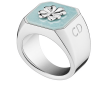The capital city of Cambodia has been slowly rebuilding itself since the country was brought to its knees by the Khmer Rouge in the late 1970s. While the scars of its terrible past can still be seen here, it’s the faces of the Cambodian people that show the country’s true spirit.
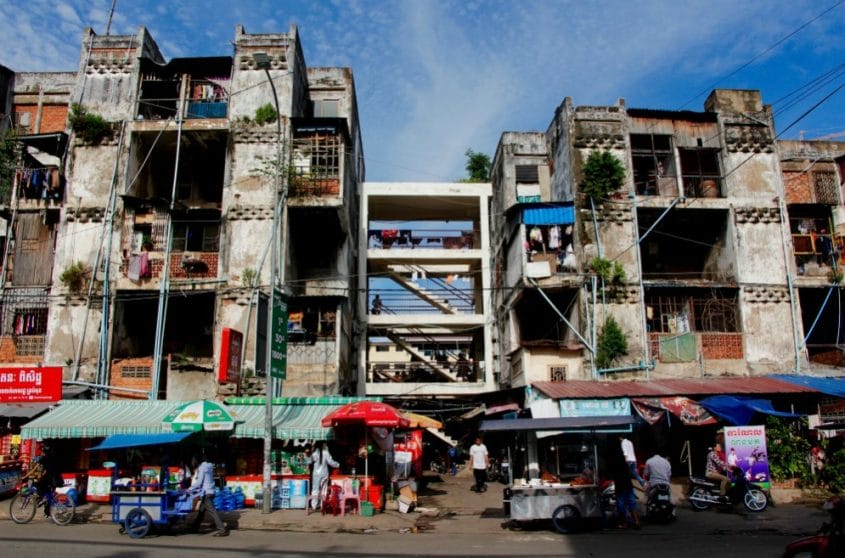
The White Building, residents and street hawkers. Photography: Jenna Milne
Arrival
Phnom Penh airport has recently had a facelift and is a pleasant point of arrival. Visas for those who need them can be purchased upon arrival before clearing customs. A general tourist visa costs USD30 (approx. RM 122.30) plus an extra USD2 (approx. RM8.20) if you don’t bring your own passport photo.
Getting Around
Tuk-tuks are a great way to get about the city, an average fare will cost about USD3 (approx. RM 12.20), but be sure to agree on a price before you jump in, otherwise you’ll be faced with a lengthy negotiation at the end of your ride.
Taxis are available but are less common and more expensive. Traffic is a nightmare during the day and worse in the evening, but if you have time and prefer the comfort of air conditioning, then this is the option for you.
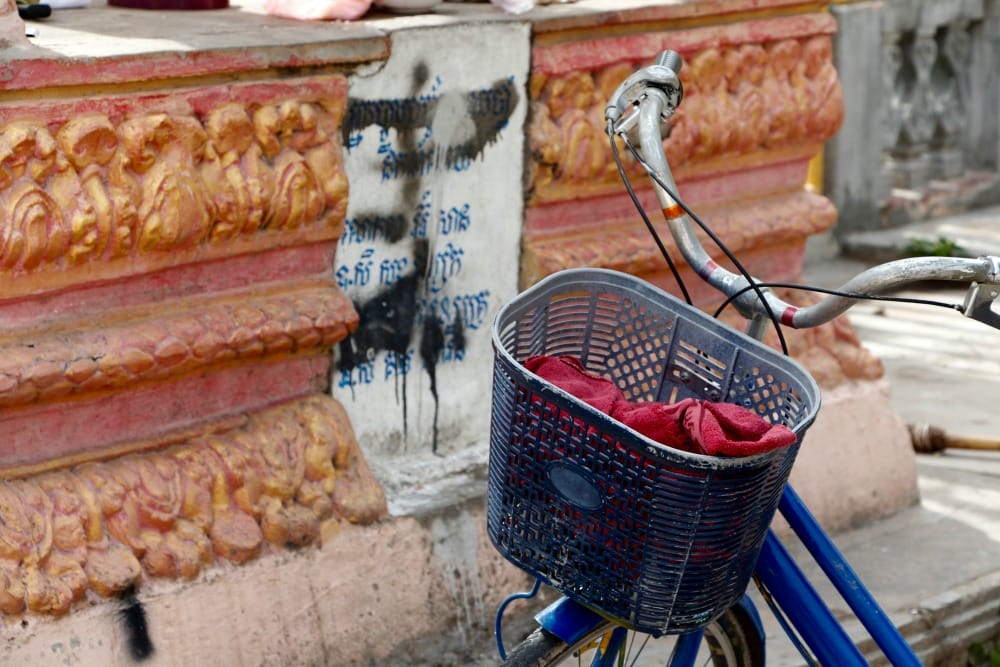
Bicycle by a Buddhist Temple, Riverside. Photography: Jenna Milne
Stay
There are a plethora of boutique hotels and homestays, as well as a few of the big name hotel chains; something for every budget.
Luxe: If you’re looking for old-world French colonial charm, splurge a little and book a stay at Raffles Hotel Le Royal. The hotel is an oasis in the city, boasting grounds lined with palm trees, high ceilings with white rafters, and a memory of a bygone golden era. Room rates range from USD240 (approx. RM978) per night including breakfast in a State or Landmark room, to USD450 (approx. RM1833.70) per night for a Suite. This includes airport round trips and a personal butler.
Boutique: Balconitel Boutique Hotel located near the Independence Monument in the area of BKK1 offers modern decor with Cambodian charm with wooden floors throughout and locally inspired artworks. The rooftop pool hosts happy hour and is a great gathering point for weary travellers to share their tales. Room rates start at USD70 (approx. RM285.30) per night for a Double Room.
Budget: One Up Banana Hotel is a slightly more up-market backpacker-style hotel. Rooms are basic but clean, and the staff go above and beyond to make you feel welcome, including making towel-shaped swans and leaving frangipani flowers on your bed. Breakfast is offered and there is a pool to relax by. Room rates from USD30 (approx. RM122.30) per night.
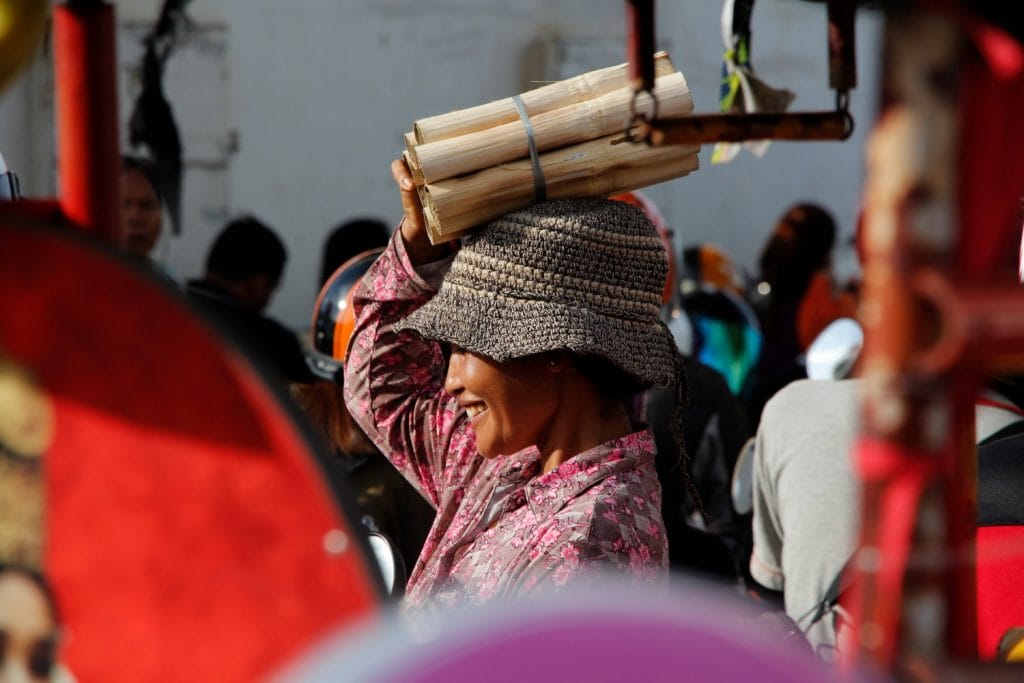
Woman selling sticky rice, Riverside. Photography by Jenna Milne

Old meets new, Pagoda and perishing building, Wat Phnom. Photography by Jenna Milne
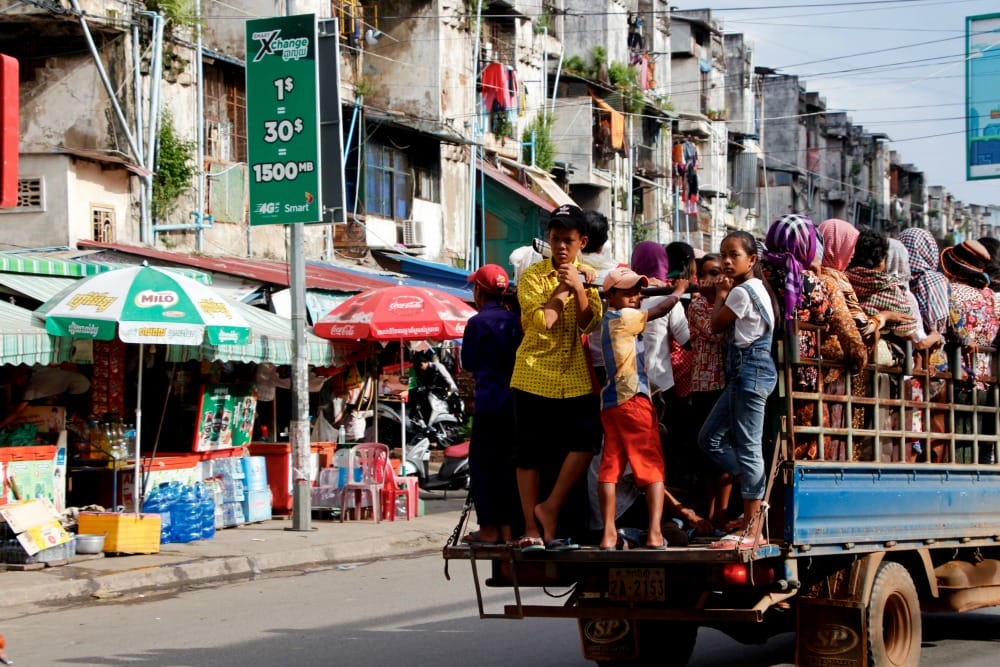
Local transportation, Boeng Keng Kang 1. Photography by Jenna Milne
See
Phnom Penh’s bustling streets are enough to kick-start your senses. Once you’ve chosen your chariot for the day (most Tuk-tuk drivers will dedicate their services to you for the entire day for a price. This saves continual negotiating and can help you feel a little more comfortable getting around), head off to one of the city’s many temples to watch the monks go about the morning.
Wat Phnom is a Buddhist temple and the city’s tallest religious structure, standing 27 metres above the ground. It sits atop a lush green hill and is cooler to visit during the morning.
The Royal Palace sits by the riverside and is home to the King of Cambodia. Parts of the palace are closed to visitors, but you can explore the throne hall and some of the surrounding khmer roofed buildings as well as the Silver Pagoda Complex.
A short walk from the palace is the National Museum in which you can walk through centuries of cultural history. It is also the country’s leading historical and archaeological museum.

Two young monks removing their hair, Wat Savonn Sakor. Photography by Jenna Milne
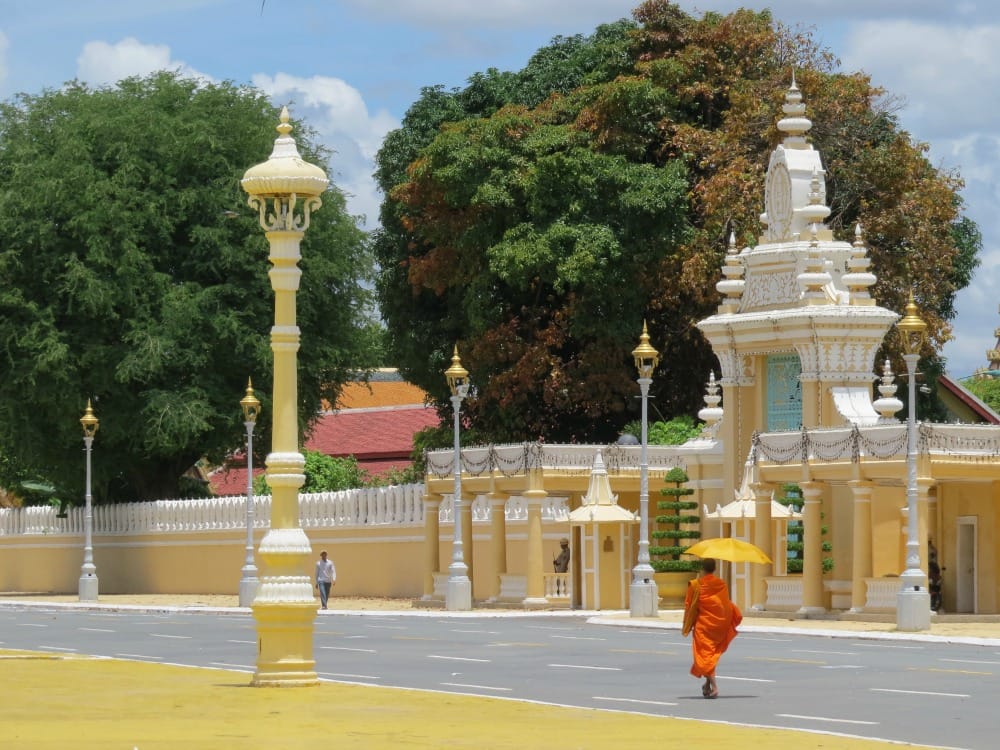
Monk on a daily commute by The Royal Palace gates. Photography by Jenna Milne
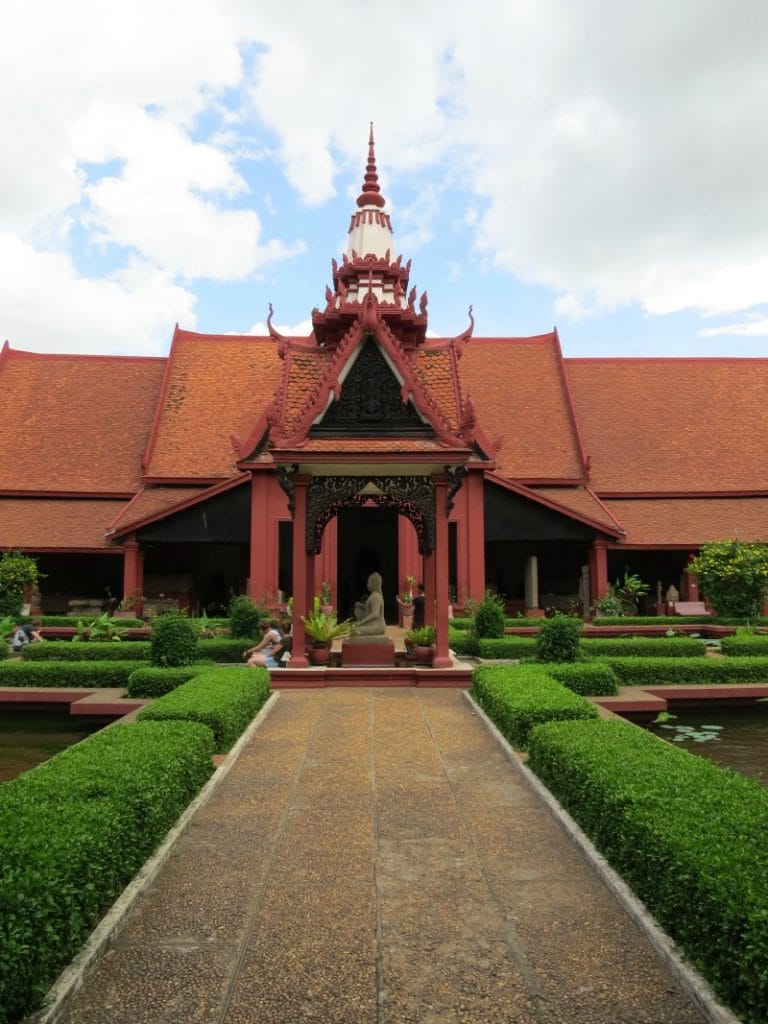
National Museum from inside the gardens. Photography by Jenna Milne

Getting around, peak hour in front of The Royal Palace, Riverside. Photography by Jenna Milne
Russian Market is a stifling bazaar heaving with vendors hawking everything you could dream of. A large range of handcrafted antiquities sit side by side silk scarves, bags and miniature Buddhas.
Every visit to Phnom Penh must include recognition of the horrific events that the country has endured. The Tuol Sleng Genocide Museum originally stood as Toul Svay Prey High School, and was taken over by Pol Pot and the Khmer Rouge during their reign and turned into a prison known as Security Prison 21 (S-21). The museum illustrates through photographs the names and numbers of the meticulously categorised prisoners who lost their lives within the walls of the prison or in one of the hundred Killing Fields. The museum is open seven days a week, from 7am to 5.30pm and costs a small fee to enter. USD2 (approx. RM8.20) for admission or USD6 (approx. RM24.50) for an audio guide.
The Killing Fields of Choeung Ek are just one of the hundreds of killing fields across Cambodia. Choeung Ek is located about 7.5km south of the city, and you will need to factor into your Tuk-tuk charges, generally around USD10 (approx. RM41) for the trip. Most of the detained souls at S-21 now rest here. The remains of 8,985 people have been exhumed from 1,980 mass graves at this site alone. 43 of the 129 communal graves have been left untouched and fragments of human bones and clothing can be seen protruding from the ground. Entry to the Killing Fields includes an audio tour, which is narrated by those who survived the Khmer Rouge, along with a chilling recount of events by Him Huy, a former Choeung Ek guard. Many people lay woven bracelets purchased from the children on the street as a sign of respect to those who lost their lives.

Bracelets left in remembrance, Killing Fields of Choeung Ek. Photography by Jenna Milne
Silk Island is a beautiful getaway from the city if you have the time. Koh Dach is a one-hour boat trip down the Mekong from Phnom Penh. It’s a rural weaving village where you can observe the workers collecting, dying, and weaving the silks on hand looms under most of the houses. The Island isn’t too popular among tourists so expect to be the centre of attention; silk sellers will do their best to hawk their wares.
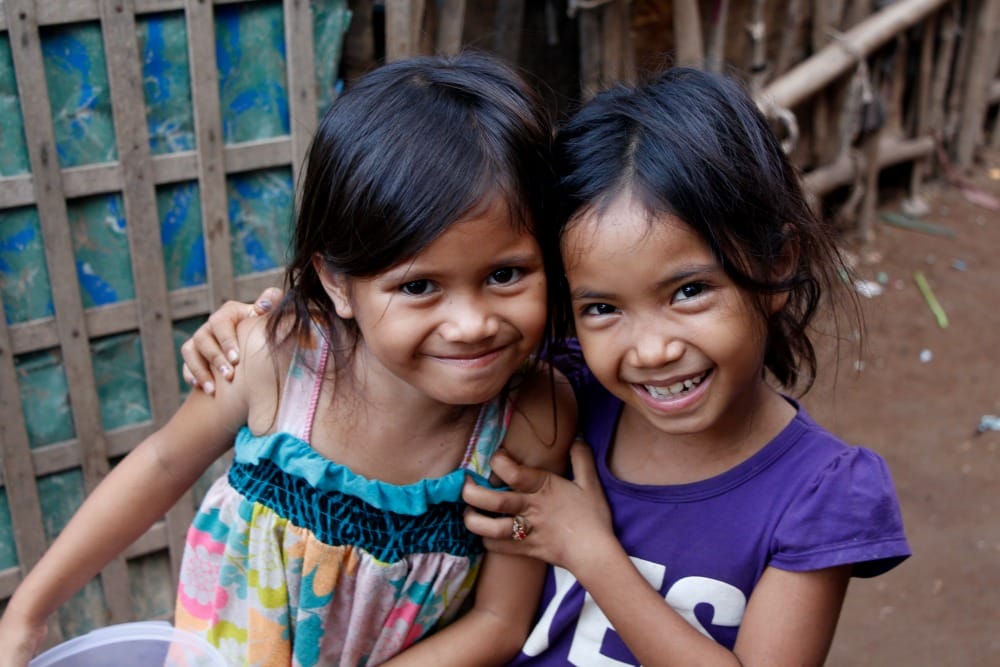
Happy faces of the children who live amongst the river people, Areyksat. Photography by Jenna Milne

Tuk-tuk by the water waiting for the ferry, Areyksat Ferry Dock. Photography by Jenna Milne
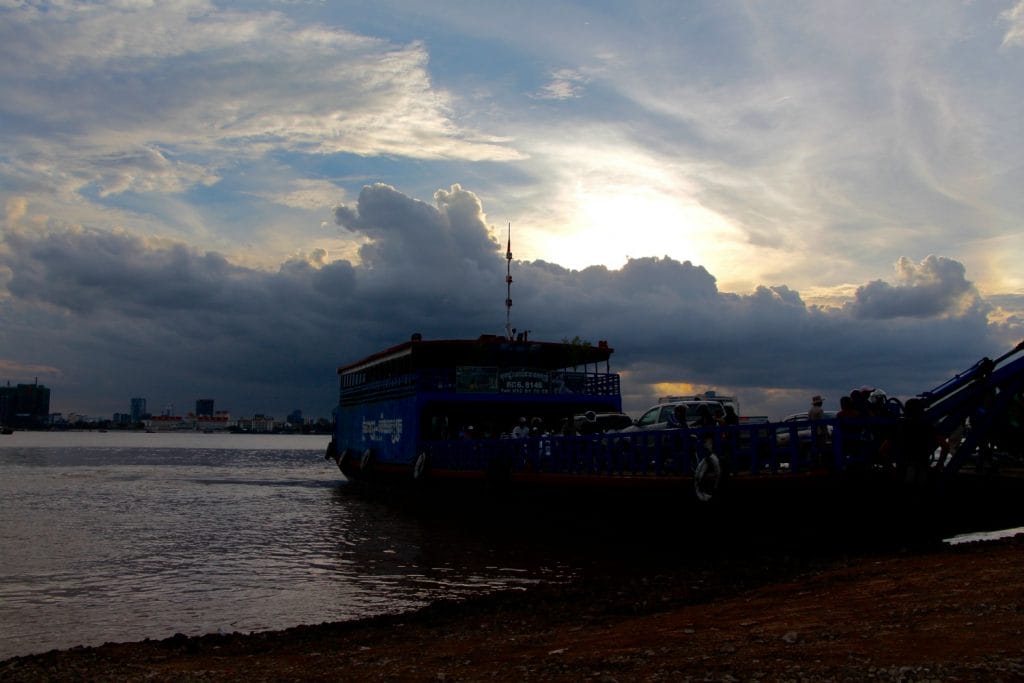
Sunset ferry preparing for departure across the Mekong, Areyksat Ferry Dock. Photography by Jenna Milne
Socialise
Some of the sights can take it out of both physically and emotionally, so rekindle your good vibes and relax in the city’s up-and-coming social spots. Happy hour can last all day at some establishments.
Glamour: The Elephant Bar located in the lobby of Raffles Hotel Le Royal is home to relaxed loungers, high wooden bar stools, and a refined signature cocktail list. Daily from 4pm to 9pm, you can enjoy half-price beer, cocktail,s and spirits while imagining Jackie O is just upstairs in her suite.
Chill Factor: Himawari Microbrewery is Cambodia’s first microbrewery. It sits right on the river with a grassy beer garden and communal tables to share stories across while watching the sun go down. From 4.30pm to 6.30pm daily, you’ll receive 30 percent off all craft beers.
History: Foreign Correspondents Club, or FCC as it’s affectionately known, stands tall in Sisowath Quay. The colonial building holds old-world charm with two balconies offering views over the Tonle Sap River (which flows into the mighty Mekong) and an open air terrace for dining. It has been the meeting place for journalists, intrepid travellers, locals, and visitors since its opening days. The walls are lined with stories from writers and photographs from the initial days of the Khmer Rouge. Two-for-one deals on beer, wine, and spirits can be enjoyed from 5pm to 7pm daily.
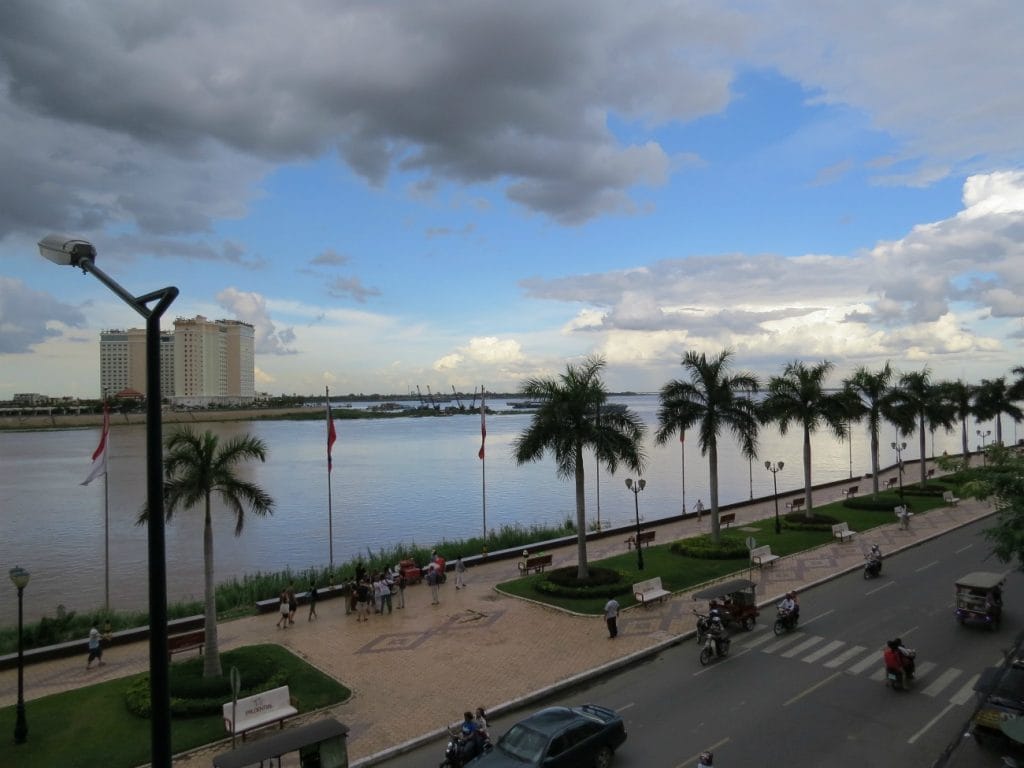
View of the Tonle Sap River from FCC, Riverside. Photography by Jenna Milne

Communal housing, Samdach Sothearos Blvd. Photography by Jenna Milne
Frequent Flyer Tip: If you want to do something for the people of Cambodia, a great way to give back to the community is by dining at one of the charitable restaurants operating in the city.
Friends the Restaurant is operated by the Friends International foundation, and can found on St 13, just by the National Museum. Famous for its frozen cocktails and fantastic tapas, the restaurant provides training for at-risk youths.
Sugar ‘n Spice Cafe is run by Daughters of Cambodia and provides support to the victims of human trafficking in Cambodia. They serve up delicious cafe-style food, from eggs Benedict to sandwiches and steaks. There is one located by Riverside and another near the Russian Market.
Black Bambu on St 228 offers fusion cuisine in a sophisticated setting. These intricate dishes are presented with such attention to detail, everything you never knew you wanted. Proceeds directly support the Cambodian Children’s Foundation.


